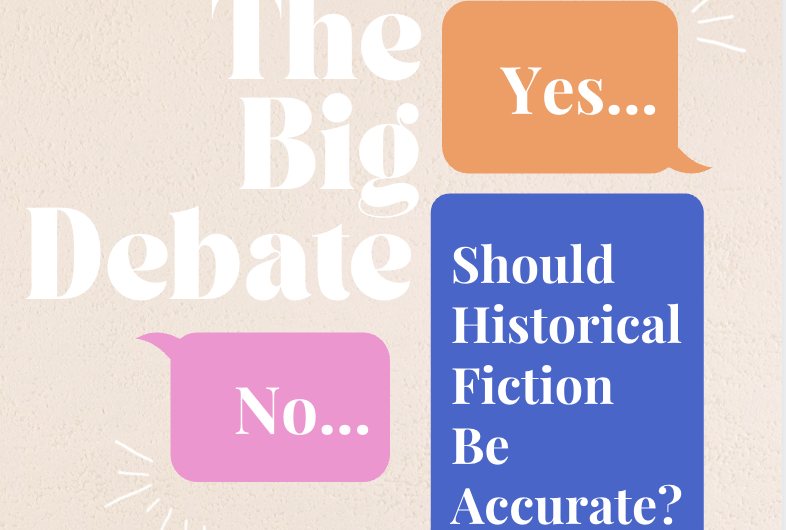YES:
Sophie McMahon, Comment Print Editor
Since picking up my first book by Philippa Gregory (an English historical novelist and University of Sussex alumni), the question of whether historical fiction should be accurate is one I have pondered over. It is a tricky, multi-faceted question to answer, especially since the term ‘accurate’ is perhaps too scientific to apply to an art (that’s a debate for another day).
With the ‘accuracy’ of history being questionable, given that it is (at least to a certain degree) a tapestry of accepted truths that has been woven of the threads of any surviving sources. Why do I feel like writers have such a duty to their readers to provide an accurate depiction of the person, place, or time that they’re writing about?
Books (as well as films and television shows) can be a window into periods in history that you might not know a lot about. The problem being that some writers can fantastically blend fact and fiction, making it hard for most of us to distinguish between the two. So much so that in 2017, John Guy wrote an article for the Guardian which claimed that students cite authors like Hilary Mantel, in applications to Cambridge to read History. With her works ‘Wolf Hall’ and ‘Bring Up the Bodies’ being some of the most well-recognised and award-winning books of historical fiction, it begs the question as to how any of us are supposed to know what’s real or false, if even the most educated young people are fooled.
For me, this means writers have some obligation not to tarnish the pages of their novel with deliberate falsehoods, or worse, anachronisms. In an age where virtually everyone has access to the internet in one way or another, it seems that major inaccuracies are just down to sloppy research but are being credited as historical license.
People read or watch historical fiction over documentaries or history books because they like a bit of storytelling and a certain atmosphere, which I completely understand. It is important to emphasise that I am not arguing that nothing in a historical fiction novel can be made up, indeed that would place it into a different genre entirely. I tend to agree with Kristen McQuinn who wrote in Book Riot that ‘only the very worst pedants would expect utter slavish adherence to historical facts in a work of fiction’. It is about utilising the facts, but also making the fiction obvious.
Philippa Gregory does an excellent job of blending fact with fiction in an excerpt from her book, The Taming of the Queen. In it, Katherine Parr sat for a painting of the family that she had just reunited; Mary, Elizabeth, Edward, and King Henry VIII, whom it was commissioned by. When the portrait was unveiled, it turned out that Katherine had been replaced by Henry’s third wife, Jane Seymour. The painting does exist named the ‘The Family of Henry VIII’ and has been dated to 1544 which was the year after Katherine became Queen. There isn’t (as far as I’ve found) any evidence that she did sit in for Jane, but it isn’t exactly implausible given when it was painted. This type of artistic license makes the resurrection of the Tudor family, who are probably the most written about monarchs, a bit more exciting by creating drama but without changing any significant historical details.
Further, the work does also contain made-up dialogue, but I would hope that readers would know that no conversation between two people who lived 500 years ago would survive until the present day. Not least because it probably wouldn’t have been written down.
History is exciting as it is. With the right research in the right area, a good writer can make a story with even the smallest number of facts, using their imagination to fill in the gaps. In trying to make the same stories more interesting, some writers have manipulated history or forged something which never happened. Given how influential these books can be, they not only tarnish the genre, but also dangerously brand a figure or period with a particular image that isn’t based on any evidence.
When reading a book or watching a film, I want to be immersed within a world which I believe in. Without fact, a historical world doesn’t really exist. Realism is not demanded, but authenticity is.
If you’re a writer not prepared to do the research please, forget the history, try writing fiction instead.
NO:
Simon Edwards, Comment Online Editor
Historical fiction’s inattention to accuracy is usually most derided in historically-based films. From the comic-book bravado of 300 (2006) to the ‘Lost Cause’ propagating American Civil War epic Gods and Generals (2003), inaccurate historical feature films are easy targets for cheap laughs and weary historian rebuttals. However, accuracy is a complex topic, often contradictory and frequently overblown; well-researched fiction taking intentional liberties can, and does, create far more potent emotional truths than slavish devotion to fact.
Biopics are easily cited examples of films where historiographic mistakes draw the ire of viewers: the majestically camp falsehood of Winston Churchill’s existential Underground conversations in Darkest Hour (2017) is a clear example. With that said, some of the genre’s most powerful films are riddled with fabrications and exaggerations. Pablo Larraín’s Jackie (2015) and upcoming Spencer (2021) mix meticulous research with semi-fantastical narratives: the impeccable recreations of Jackie’s experiences before and after her husband’s assassination align perfectly with moments of fantasy, and both are essential to the film’s immersive tragedy. Some biopics go further, with films like Amadeus (1984), whose director openly declared it “fantasia” based on the apocryphal rivalry between Mozart and Salieri, representing both powerful historical truth and total fiction in synthesis.
Historical cinema’s ability to stimulate emotional reactions to the past unquestionably requires accuracy, but invention has its place. For many film fans, the most powerful depiction of the horrors of the Holocaust is Spielberg’s Schindler’s List (1993). Aside from occasional narrative-mandated alterations, the film is a faithful and potent retelling of the life of Oskar Schindler, and an unflinching portrayal of the attempted extermination of Krakow’s Jewish population; its strength lies in its accuracy, which allows it communicate a truth many consider almost documentarian.
There are nonetheless other films that courageously tackle the topic, focused less on documentarian realism but potent fictional evocation, with similarly – or even more – successful results. Son Of Saul (2015), a Hungarian drama set in Auschwitz in 1944, captures a level of brutality that Spielberg’s epic fails to match, while telling an entirely fictionalised narrative which an Auschwitz Memorial review described as “not focused on the reconstruction of the details but on showing the spirit and the atmosphere of those historical events”. Conversely, Roberto Benigni’s Oscar-winning Life Is Beautiful (1997), about an Italian-Jewish man protecting his family during their concentration camp internment, provides a boldly fictionalised portrayal of the Holocaust that invokes slapstick humour and pathos in equal measure. The degree to which each of these films is ‘accurate’ varies, but all leave their audiences with a truly powerful understanding of the Holocaust.
The notion of ‘accuracy’ is worth interrogating; history’s ever-changing nature complicates the value of slavish realism, as research can challenge even fundamental ‘truths’. A Night To Remember (1958) – a personal favourite- is a thoroughly researched drama based on the sinking of the Titanic. Based on a book of survivor testimonies, it is both “an emotive portrayal of Britishness in crisis”, as per Mark Kermode, and the most meticulously accurate Titanic film ever put to screen. Titanic (1997) drew heavily on its camera-work, its research, but instead focused on a fictionalised plot of young love, diamond heists and rejected playboys chasing Leonardo DiCaprio and Kate Winslet with a revolver.
On the surface (pun unintended), it’s pretty clear which of the films is the ‘true’ account of the sinking – Remember’s flawless attention to detail makes it the firm favourite of aspiring Titanic buffs. However, the film utterly fails to capture the truth of the sinking due to one fatal flaw, which Titanic gets right – in Remember, the ship sinks intact, when in truth, during its death-throes, the hull tore in half. The reason for this blunder is simple: in 1958, that is how official reports understood the ship to have sunk. Numerous dissenting accounts were dismissed, and only corroborated in 1986 with Robert Ballad’s discovery of the wreck on the Atlantic seabed.
So the question is: which film is more accurate? The 1958 film, utterly faithful to facts later disproven, or the fictional 1997 romance that captured a more realistic portrayal of the sinking than its predecessor ever could, despite many young fans believing the ship to be fictional anyway? History is not always static, and its truths are not set in stone. Rather than slavishly obey the facts, historical fiction should focus on capturing a tone, a spirit, that facilitates a great story. Stories that endure and inspire for generations are worth a few misplaced swords and sequins.





